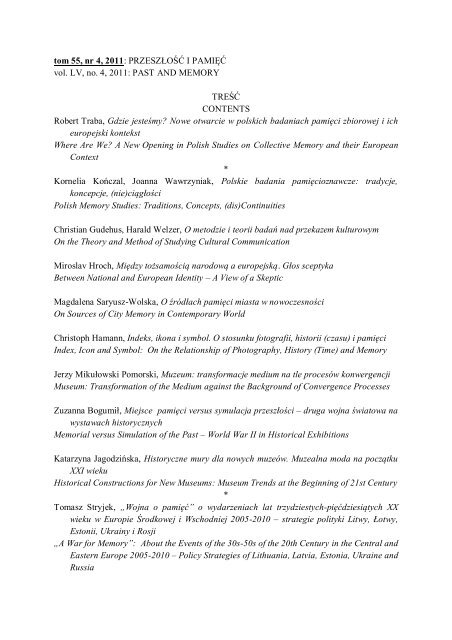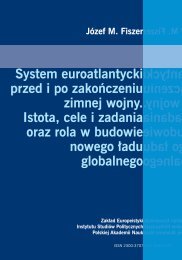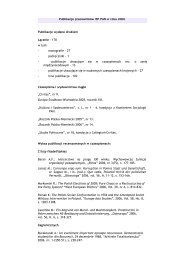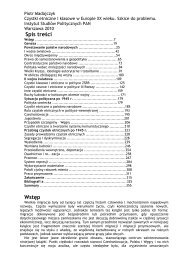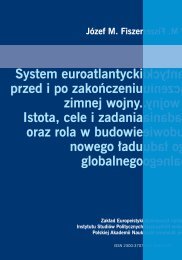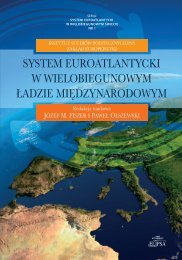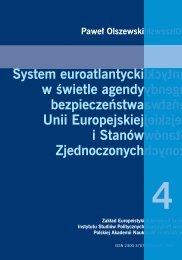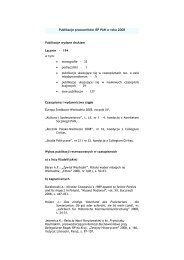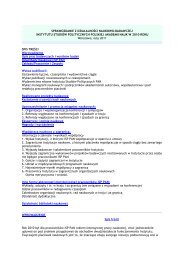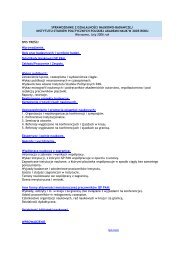Kultura i SpoÅeczeÅstwo t. 55 nr 4/2011
Kultura i SpoÅeczeÅstwo t. 55 nr 4/2011
Kultura i SpoÅeczeÅstwo t. 55 nr 4/2011
- No tags were found...
Create successful ePaper yourself
Turn your PDF publications into a flip-book with our unique Google optimized e-Paper software.
tom <strong>55</strong>, <strong>nr</strong> 4, <strong>2011</strong>: PRZESZŁOŚĆ I PAMIĘĆvol. LV, no. 4, <strong>2011</strong>: PAST AND MEMORYTREŚĆCONTENTSRobert Traba, Gdzie jesteśmy? Nowe otwarcie w polskich badaniach pamięci zbiorowej i icheuropejski kontekstWhere Are We? A New Opening in Polish Studies on Collective Memory and their EuropeanContext*Kornelia Kończal, Joanna Wawrzyniak, Polskie badania pamięcioznawcze: tradycje,koncepcje, (nie)ciągłościPolish Memory Studies: Traditions, Concepts, (dis)ContinuitiesChristian Gudehus, Harald Welzer, O metodzie i teorii badań nad przekazem kulturowymOn the Theory and Method of Studying Cultural CommunicationMiroslav Hroch, Między tożsamością narodową a europejską. Głos sceptykaBetween National and European Identity – A View of a SkepticMagdalena Saryusz-Wolska, O źródłach pamięci miasta w nowoczesnościOn Sources of City Memory in Contemporary WorldChristoph Hamann, Indeks, ikona i symbol. O stosunku fotografii, historii (czasu) i pamięciIndex, Icon and Symbol: On the Relationship of Photography, History (Time) and MemoryJerzy Mikułowski Pomorski, Muzeum: transformacje medium na tle procesów konwergencjiMuseum: Transformation of the Medium against the Background of Convergence ProcessesZuzanna Bogumił, Miejsce pamięci versus symulacja przeszłości – druga wojna światowa nawystawach historycznychMemorial versus Simulation of the Past – World War II in Historical ExhibitionsKatarzyna Jagodzińska, Historyczne mury dla nowych muzeów. Muzealna moda na początkuXXI wiekuHistorical Constructions for New Museums: Museum Trends at the Beginning of 21st Century*Tomasz Stryjek, „Wojna o pamięć” o wydarzeniach lat trzydziestych-pięćdziesiątych XXwieku w Europie Środkowej i Wschodniej 2005-2010 – strategie polityki Litwy, Łotwy,Estonii, Ukrainy i Rosji„A War for Memory”: About the Events of the 30s-50s of the 20th Century in the Central andEastern Europe 2005-2010 – Policy Strategies of Lithuania, Latvia, Estonia, Ukraine andRussia
Key words / słowa kluczoweEuropean identity / tożsamość europejska; nation / naród; nationalism / nacjonalizm;historical consciuosness / świadomość historycznaMagdalena Saryusz-WolskaRefleksja nad miejskim doświadczeniem nowoczesności rozwijała się równolegle dorozważań o pamięci zbiorowej. Z przestrzenią miejską związana jest metafora palimpsestu,która wpisuje pamięć miasta w historię pamięci rozumianą jako historia mediów. W ostatnichlatach związek pamięci i miasta analizowany jest na przykładach naznaczonychwielokulturowością i ruchami migracyjnymi miast Europy Środkowej, np. w monografiiWiednia ok. roku 1900 Das Gedächtnis der Städte (Pamięć miast) autorstwa MoritzaCsakyego. W paradygmacie medialnym natomiast porusza się Christine Boyer, analizując wksiążce The City of Collective Memory wizualne manifestacje pamięci miasta. Z zestawieniadwóch wzajemnie uzupełniających się podejść badawczych należałoby wywieść postulatypogłębienia refleksji nad rolą kultury popularnej i wizualności w kształtowaniu się pamięcimiast oraz dalszych badań nad przekraczającymi granice państwowe i narodowe „splotamikulturowymi”.S u m m a ryThe analysis of urban experience of modernity developed simultaneously with the analysis ofcollective memory. Urban space is related with a palimpsest metaphor, which includes urbanmemory in the history of memory understood as a history of the media. In recent years therelationship between memory and a city is analyzed on the examples featuringmulticulturalism and migration movements of the cities of the Central Europe, e.g. in theVienna monograph ca. 1900 Das Gedächtnis der Städte (The Memory of the City) by MoritzCsaky. On the other hand, the media paradigm is used by Christine Boyer, who analysesvisual manifestations of city memory in her book The City of Collective Memory.Juxtaposition of the two mutually complementing scientific attitudes invokes a need topostulate a deeper analysis of the role of popular culture and visuality in shaping the memoryof cities, as well as conducting further studies on cross-country and transnational ‘culturaltangles’.Key words / słowa kluczowememory of a city / pamięć miasta; multiculturalism / wielokulturowość; visuality / wizualność/Christoph HamannAutor wychodzi od stwierdzenia, że fotografia i nowoczesna historiografia powstały w tymsamym czasie, a następnie poszukuje między nimi powiązań. Rozpoczyna od analizyspecyfiki zdjęcia fotograficznego, które - jako medium - nie tylko reprezentuje przeszłość,lecz w teraźniejszości i przyszłości może stanowić impuls pobudzający do działania. Sięgającdo semiotycznej klasyfikacji Charlesa Sendersa Peirce’a, pokazuje, na czym polega ważna dlanauk historycznych funkcja fotografii jako indeksu, ikony i symbolu. Pomaga to zrozumiećsposób posługiwania się zbiorowym zasobem zdjęć oraz określić status zdjęć cyfrowych jakoźródła. Na koniec podejmuje próbę pokazania perspektyw analizy visual history oraz tego,5
jaką rolę mogą pełnić obrazy przy formowaniu i zmienianiu wspólnot pamięci w epoceglobalizacji i dywersyfikacjiS u m m a ryThe Author starts with a thesis that photography and modern historiography developed at thesame time, and then tries to look for relationships between the two. He starts from analyzing aspecificity of a photograph which – as a medium – not only represents the past, but can be anenergizing impulse both in the presence and the future. By referring to the semioticclassification of Charles Senders Peirce, the Author describes the importance of a photographto historical research as an index, an icon and a symbol. This helps understand the way ofusing a collective resource of photographs and to define a status of digital photographs as asource. Finally, the Author tries to show the perspectives of visual history analysis and therole which might be played by images when forming and changing memory communities inthe era of globalization and diversification.Key words / słowa kluczowephotography / fotografia; history / historia; medium / medium; image /obraz; memorycommunity / wspólnota pamięciJerzy Mikułowski PomorskiAutor zastanawia się nad przemianami instytucji muzeum, traktując je jako medium. Bierzepod uwagę jego cechy konstutytywne: przestrzenność i pełnienie funkcji przekazu. Jegozdaniem, w dzisiejszym świecie konwergencji kultury muzea, niegdyś ograniczoneperspektywą instytucjonalną, skierowały uwagę na potrzeby i doświadczenia widza – stałysię ziemią, którą ludzie mogą zagospodarować według swych grupowych potrzeb.S u m m a ryThe Author ponders changes in the perception of the institution of museum, which he treats asa medium. He considers its constitutive features: spatiality and transfer function. In hisopinion, in the contemporary world of cultural convergence the museums, once limited withinstitutional perspective, targeted their attention at the needs and experiences of a viewer –they have become a piece of land which may be developed by people according to their owngroup needs.Key words / słowa kluczowecontermporary culture / kultura współczesna; museum / muzeum; medium / mediumZuzanna BogumiłThe Author examines the presentation of the German occupation at the Warsaw RisingMuseum and in Oskar Schindler’s Enamel Factory in Krakow. Initially, she studies the spaceof these exhibitions and demonstrates that the Warsaw Rising Museum has somecharacteristics of reflective space, while the exhibition at the Schindler's Factory is primarily aprojective one. Then, she points out that both museums treat artefacts as illustrations of theirstories, as a consequence of which they are simulations of the past rather than materialtestimonies of what had happened. Finally, the Author argues that the Warsaw RisingMuseum primarily tells the story of glory of the Polish nation, while the Schindler Factoryfocuses on the social history. In conclusion the Author points out that none of the exhibitions6
century – the majority of newly-established museums are located in adapted old buildings, themuseums representing almost exclusively only two categories: historical museums andcontemporary art museums. The Author seeks an answer to a question whether museums mustfollow current trends. She concludes that a quest for success translating to a good image andhigh attendance is and certainly shall remain an important goal of a museum. She warns,however, of dangers related with a museum trying to be a ‘trendy’ place to attend, especiallyin the times of public life commercialization, which is more and more common.Key words / słowa kluczowehistorical museums / muzea historyczne; museums of contemporary art / muzea sztukiwspółczesnej; postindustrial architecture / architektura postindustrialnaTomasz StryjekIn his article the Author examines the notion of remembrance policy, the importance ofremembering the events of the period 1939-1953 for contemporary identity politics in thecountries of Central and Eastern Europe: Poland, Ukraine, Lithuania, Latvia and Estonia aswell as the course of a conflict about the memory, which escalated between those countriesand Russia particularly between 2005-2010. The Author introduces a term "remembrancepolicy model ", which concerns the balance of powers among political actors in a givenstate, who influence the shape of this aspect of the state policy. He also analyses the statestrategies of the remembrance policy in international relations within the region, with specialattention to Lithuania and Ukraine. He examines reasons for the success of the policy ofremembering the 1939-1953 events in Lithuania in 1991-<strong>2011</strong> and a failure of such policy inUkraine in 2005-2010. The sources of difference between the effects of these two policieslie, in his opinion, not only in far greater ethnic and identity homogeneity of the Lithuaniansociety, but also in the fact that the EU gave an early, clear and consistent support foreconomic, social and political transformation of that country, which was, unfortunately, notprovided to Ukraine - either after its establishment in 1991, or after the Orange Revolutionin 2004.S u m m a ryAutor analizuje pojęcie polityki wobec pamięci, znaczenie pamięci o wydarzeniach okresu1939-1953 dla współczesnej polityki tożsamości w państwach Europy Środkowej iWschodniej: Polski, Ukrainy, Litwy, Łotwy i Estonii oraz przebieg konfliktu o pamięć, jakize szczególną siłą toczył się między nimi a Rosją w latach 2005-2010. Autor wprowadzatermin „model polityki wobec pamięci”, który dotyczy układu sił między podmiotamipolitycznymi w danym państwie wpływającymi na kształtowanie tej polityki. Zajmuje siętakże strategiami państwowej polityki wobec pamięci w stosunkach międzynarodowych wtym regionie, szczególną uwagę poświęcając Litwie i Ukrainie. Rozpatruje przyczynysukcesu polityki wobec pamięci o wydarzeniach okresu 1939-1953 na Litwie w latach 1991-<strong>2011</strong> oraz fiaska takiej polityki na Ukrainie w latach 2005-2010. Źródła tej różnicy tkwią,jego zdaniem, nie tylko w zdecydowanie większej homogeniczności etnicznej itożsamościowej Litwy, lecz także w tym, że UE udzieliła wczesnego, jednoznacznego ikonsekwentnego poparcia dla transformacji gospodarczo-społecznej i politycznej tegopaństwa, nie nastąpiło to natomiast w odniesieniu do Ukrainy – ani po jej powstaniu w 1991r., ani po pomarańczowej rewolucji w 2004 r.8
Key words / słowa kluczoweremembrance policy / polityka wobec pamięci; identity politics / polityka tożsamości; WorldWar II / druga wojna światowa; Nazi and Soviet crimes / zbrodnie nazistowskie i sowieckie;the Holocaust / Holokaust; genocide / ludobójstwo; war for memory / wojna o pamięćJoanna B. MichlicAutor artykułu snuje rozważania na temat pamięci o stosunkach polsko-żydowskich podczasHolokaustu w Polsce w okresie od 2002 r. do dnia dzisiejszego, w następstwie intensywnejdebaty publicznej o pogromie w Jedwabnem, który miał miejsce 10 lipca 1941 r. Cienkamonografia Jana Tomasza Grossa pt. „Sąsiedzi”, opublikowana w maju 2000 r., wywołaładebatę, która rozpoczęła proces samokrytycznej oceny stosunku narodu polskiego wprzeszłości do mniejszości żydowskiej i innych mniejszości etnicznych, tzw. kulturalneodrodzenie pamięci narodowej. Dziesięć lat później nadal istnieje ostry podział międzygrupami polskich polityków, intelektualistów, dziennikarzy, historyków i społeczeństwa wogóle, dotyczący sposobu w jaki ocenia się mroczne aspekty stosunków polsko-żydowskichpodczas i po drugiej wojnie światowej. Autor artykułu przedstawia główne metodypamiętania o Żydach i Holokauście: „pamiętać dla pamięci”, „pamiętać dla korzyści”, i„pamiętać, by zapomnieć”, oraz różne manifestacje tych trzech sposobów, a także analizuje,dlaczego Polakom tak trudno jest sprawić, by ciemne strony ich historii stały się częściąświadomości historycznej i pamięci narodowej.S u m m a ryThe paper considers the memories of Polish-Jewish relations during the Holocaust in Polandin the aftermath of the intense public debate about the Jedwabne massacre of July 10, 1941,since 2002 till the present. Jan Tomasz Gross’s slim monograph Neighbors, published in May2000, triggered a debate that generated a process of self-critical assessments of the Polishnational past in relation to Jewish and other ethnic minorities, the so-called cultural renewalof public memory. Ten years later there is still a sharp split between groups of Polishpoliticians, public intellectuals, journalists, historians and members of society at large in howthey evaluate the dark aspects of the Polish-Jewish relations during and after WWII. Thepaper examines the main modes of remembering Jews and the Holocaust: "remembering toremember", "remembering to benefit", and "remembering to forget", and the differentmanifestations of these three modes, and discusses what has made it difficult for Poles tointegrate the dark past into popular historical consciousness and public memory.Key words / słowa kluczowemodes of remembering of Jews and the Holocaust / sposoby pamiętania o Żydach iHolokauście; memorialization of the Holocaust / upamiętnienie Holokaustu; politicization ofrescuers of Jews / upolitycznienie ratujących Żydów9
Antoni SułekArtykuł zawiera próbę oceny efektu społecznego książki „Złote żniwa”, opublikowanej napoczątku <strong>2011</strong> r. przez Jana Tomasza Grossa i Irenę Grudzińską-Gross. Autorzy ujawnilifakty, skalę i motywacje udziału Polaków w mordowaniu i rabowaniu Żydów w NazioccupiedPoland. Pokazali, że skala zbrodni popełnionych na Żydach była większa niż dotądpisano i argumentowali, że była ona większa niż udzielana im pomoc. Książka wywołała wPolsce ostra debatę publiczną.Na podstawie sondażowych badań opinii publicznej autor pokazuje, że efekt „Złotychżniw” jest złożony. Zapewne książka i debata ożywiły społeczną pamięć przemocy, rabunkówi mordów dokonanych na Żydach. Przypuszczalnie przekonały też jakąś, niewielką częśćPolaków, że takie fakty, i to liczne, miały miejsce, oraz sprawiły, że znacząca część Polakówmyśli, że mogło tak być. Dyskusja nie zmieniła natomiast ogólnej i wartościującej opinii opostawie Polaków wobec Holokaustu. Autor próbuje wyjaśnić, dlaczego książka wywołałaskutki znacznie mniejsze niż oczekiwali jej autorzy? Odpowiedzi szuka w nastawieniachPolaków i rodzaju przekonań, które „Złote żniwa” miały zmienić; w cechachcharakterystycznych książki i debaty przez nią wywołanejS u m m a ryThe article is an attempt to assess a social impact of the book „Golden Harvest”, published atthe beginning of <strong>2011</strong> by Jan Tomasz Gross and Irena Grudzińska-Gross. The authors of thebook have revealed facts, scale and motives of participation of the Polish citizens in killingand robbing Jews in the Nazi-occupied Poland. They have demonstrated that the scale ofJewish homicide was broader than hitherto described, and argued that it was greater than thescope of help provided to the Jews. The book triggered a fiery public debate in Poland.Based on the research polls the Author of the article demonstrates that the impact of “GoldenHarvest” is quite complex. The book and the debate did activate the social memoryconcerning violence, burglary and killings of the Jews. Supposedly, they also persuadedsome scarce number of Poles that such facts, quite numerous, did happen and made asignificant number of Poles think that it might have been so. The discussion did not, however,change an overall and valuating opinion about the attitude of Poles towards Holocaust. TheAuthor tries to explain why the book’s effect was far less spectacular than its authors hadexpected. The answer is looked for in the attitudes of Poles and the type of beliefs that were tohave been changed as a result of publishing ‘Golden Harvest’, as well as in the specificfeatures of the book and the debate triggered by it.Key words / słowa kluczowestosunki polsko-żydowskie / Polish-Jewish relations; Holocaust / zagłada Żydów; Jan TomaszGrossJakub KnyżewskiArtykuł poświęcony jest dokonaniom środowiska skupionego wokół czasopisma „Borussia.<strong>Kultura</strong>. Historia. Literatura”, które – kierując się konstruktywistyczną wizją historii –poszukuje odpowiedzi na pytanie o rolę dziedzictwa Prus Wschodnich i Niemiec wewspółczesnej Polsce. Podjęło tym samym zadanie nie tylko badania przeszłości regionu, aletakże tworzenia współczesnego społeczeństwa obywatelskiego świadomego przeszłości10
ziemi, na której żyje. Elementy wielokulturowego obrazu Prus Wschodnich wyłaniającego sięz tekstów „Borussii” tworzą metaforyczną „Atlantydę Północy”, wyidealizowanąwielokulturową krainę, w której dominuje duch tolerancji. Obraz taki wraz z ideą „otwartegoregionalizmu” składa się na preferowaną wizję współczesnej tożsamości regionalnej.S u m m a ryThe article elaborates on the accomplishments of those centered around a magazine„Borussia. Culture. History. Literature” which, while following a constructivist vision ofhistory, seeks an answer to a question about a role of the heritage of East Prussia andGermany in contemporary Poland. Thus, a challenge has been taken to not only examine theregion’s past, but also to examine the creation of contemporary civil society which is aware ofwhat was the past of the land on which they live. Elements of multicultural image of EastPrussia emerging from ‘Borussia” articles create a metaphoric “Atlantis of the North” –idealized multicultural land, dominated by the spirit of tolerance. Such an image, togetherwith the idea of ‘open regionalism’ comprises a preferred image of contemporary regionalidentity.Key words / słowa kluczoweconstructivism in historiography / konstruktywizm w historiografii; memory of the past /pamięć przeszłości; multiculturalism /wielokulturowość; regionalism / regionalizm11


